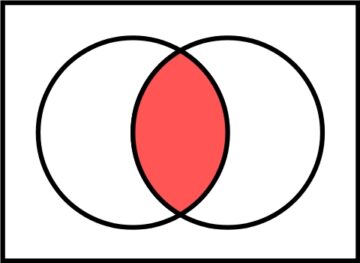by Jochen Szangolies

When asked about the foundational technologies of human civilization, most people will probably point to the wheel, or fire, or maybe the lever. Perhaps the atlatl as arguably humanity’s first machine might make the cut. Few, I think, would point to the humble fence: rather than being a construct, fences often seem to us merely a recognition of divides already present, and thus, hardly a separate technology on their own. The land is divided according to ownership, and the fences erected upon it merely mark this preexisting reality.
In truth, fences, both physical and metaphorical, fulfill an important role in the transition from a natural, unmodified, technology-free world to a reality structured according to human design. Their prevalence in metaphor is evidence of this: you can sit on them, tear them down, they are in our heads, the grass is greener on their far side, good ones allegedly make good neighbors, you can mend them, or swing for them in an attempt to achieve your most far-out performance.
The primary role of the fence is that of demarcation. Put on an originally pristine plain, it divides it into a ‘here’ and a ‘there’. Interpreting each side in terms of possession, it distinguishes between ‘mine’ and ‘theirs’; in terms of identity, it separates ‘us’ from ‘them’. It takes a continuum of possibilities and replaces it with a sharp distinction. As such, it is the original digital technology.
(Parenthetically, fences are also the original capitalist technology: not just in defining the notion of ownership, but through the concept of enclosure, the appropriation of common land that was worked by all, to be rented back to its original cultivators.)
Fences are the ultimate expression of the human tendency to categorize, to parcel off, to structure. They are a quintessentially lobsterian creation: as its hard carapace rigidly shields its vulnerable interior from a dangerous environment, so does the fence protect the shepherd’s flock from the roaming wolf. As the lobster’s analytic claw dissects whatever catches its attention, so do fences slice the land into discrete plots.
There is no question of the usefulness of fences. But the impulse to dissect, to rein in, and to replace vague continua with clear boundaries can all too easily result in a misplaced concreteness where real ambiguity exists, and in hard dichotomies where the reality is one of continuity across perceived differences.
Fence And Form
The motion expressed by the erection of a fence can validly be said to be the fundamental thought movement at the heart of classical, Boolean logic. That motion is the making of a distinction: differentiating this from everything else, and by that, making it amenable to conceptual grasp. As argued in 1969 by George Spencer-Brown in his quasi-mystical work of mathematical philosophy, Laws of Form, “once a distinction is drawn, the spaces, states, or contents on each side of the boundary, being distinct, can be indicated”.
For Spencer-Brown, distinction is what makes indication possible: literally, we draw a boundary to be able to point at one side as ‘this, here’ and the other as ‘that, there’. From this, he goes on to create a mathematical system—the Laws of Form (LoF)—based entirely on the notions of distinction and indication.
Spencer-Brown introduces the ‘Mark’ or ‘Cross’ ┐, whose sole function is to act as a demarcation between areas of the blank page. In this, it is the elementary idea of a fence: and here, we already see that it is not the differences in the world that are merely marked by the erection of a fence, but rather, that it is the fence that first makes indicating these differences possible. We start with the blank page (or the unworked land), which is aconceptual, incapable of being directly indicated or grasped, and draw a distinction to separate it into concepts of ‘this’ and ‘that’ we can get mental purchase on.
Having drawn this first distinction, we need rules that specify what happens once further distinctions are introduced. There are two basic possibilities: a distinction within a distinction (a fence inside of a fence), and another distinction besides the first one (another fenced-off area). In LoF, the making of a distinction is a move from the ‘unmarked’ to the ‘marked’ state, from ‘nothing’ to ‘this thing’. Marking again then moves back to the unmarked state, like crossing (or Crossing) a fence twice: ╗ = , where there is nothing but a blank to the right of the equals sign. A separate Mark, on the other hand, marks the same distinction, like fencing in another plot of land as ‘yours’: ┐┐ = ┐.
From this, Spencer-Brown constructs what he terms the ‘primary algebra’. For us, the salient point is simply that the primary algebra can be interpreted in terms of (the two-element) Boolean algebra, or in other words, classical bivalent logic—the calculus of true and false, or the binary system of 0 and 1 underlying modern computer technology. More than 100 years before Spencer-Brown, George Boole had introduced the laws governing logical reasoning in his book The Laws of Thought (well, An Investigation of the Laws of Thought on Which are Founded the Mathematical Theories of Logic and Probabilities, but that’s a bit of a mouthful). Thus, we have moved from form, from distinction and fences to the rules governing logical argumentation.

Incidentally, Boole’s laws are themselves often expressed in terms of fences slicing the plane: Venn diagrams consisting of intersecting ‘fenced’ areas represent truth values of combinations of elementary propositions, such as ‘it is morning and it is raining’.
Fences, and the distinctions they draw, are thus at the heart of that sort of logic that sharply divides propositions in true or false, yes or no; and while, as modern technology amply demonstrates, this is a powerful tool, it leaves little room for the ambiguous, for maybe, for the vague. This might be thought to be a good thing: at the outset of Western philosophy (or at the very least, at a juncture important enough to fence off its history into a before and after) stands Socrates, with his insistence on crisp and unambiguous definitions, with his series of questions that leave his interlocutors little room to hide behind muddled concepts and unclear phrases. (And in fact, often leave them little role but to meekly assent to his interjections.)
But there are dangers to drawing arbitrary distinctions in fields that might be better served by recognizing their inherently ambiguous nature. If we thus accept that the investigations of Boole and Spencer-Brown have uncovered something of the fundamental structure of human thought in our tendency to distinguish and categorize, to fence in, we should do well to be aware of the way in which it may bias our apperception of the world.
The Pharisees’ Fence
One of the few images that have stuck with me from High School religious studies is that of a fence drawn symbolically around the ten commandments. The ‘fence’ in question consists of a set of auxiliary laws, rules and norms whose sole object was to serve as insulation against infringement of the actual laws. Thus, on the Sabbath, it was prohibited to spit on the ground, because the resulting mud was mortar, and hence, you might have run afoul of the prohibition against working. Spitting upon a rock, however, was fine.
The problem with such ‘fence laws’, now, is that they can easily come to supplant the actual laws they were originally supposed to merely safeguard. Thus, there is nothing per se wrong with spitting on the ground; it is only running afoul of the prohibition against working on the Sabbath that constitutes a transgression. But with the fence in place, the spitting itself becomes a prohibited act. Thus, we have a kind of moral ‘goal creep’: attempting to safeguard one set of rules by fencing it off with auxiliary rules leads to the latter taking the place of the former.
It is not hard to see why the erection of such ‘fences’ might seem a good idea. Every law, every rule has gray areas, is subject to ambiguity and vagueness. What, for instance, exactly constitutes ‘work’? Socrates surely could have a field day with that question. A vague concept such as this seems a poor target for a rule. Its lack of specificity then means that we can’t get conceptual purchase upon the subject—we have no clear dividing line between ‘work’ and ‘not work’. Thus, we need to draw a distinction—build a fence.

Fences thus replace vagueness and ambiguity with clearly defined boundaries. They eliminate the unease that lies in the confrontation with the liminal by providing a sharp transition in place of an ‘unruly’, ungoverned transitional space. As argued in a previous column, liminal spaces—real or metaphorical—are areas of uncertain status between spaces governed by different rules. They are thus transitional: we pass through liminal areas, or liminal states, in the transition from being governed by different sets of rules, such as that from child to adult. Many cultures mark such transitions with rituals, and they are often associated with a certain sort of danger: an improperly carried out ritual might lead to a ‘stuck’ state, and can lead to social ostracism.
What else to do then other than to eliminate the liminal, erect a firm fence right through it, excluding the offending middle? The danger is twofold: one, with there being no objectively right way to draw the boundary, the result will always be arbitrary to some degree, and two, the aforementioned replacement of the original—perhaps very well founded and necessary—rule by a far less obviously sensible ‘fence’. This results in what might have been a set of reasonable rules assuming both an air of capriciousness, and in trapping those who may have agreed on the importance of the original rule perhaps on opposite sides of the fence.
To take the above example, if you hold the law of the Sabbath holy, you might well find it reasonable to avoid spitting onto the ground, just to err on the side of caution. Then again, while agreeing to the holiness of Sabbath, you may well think that’s utter nonsense, and ‘work’ really needs to include something like directed, strenuous activity. These are both not entirely unreasonable positions to take, and what’s more, they agree in their core—proponents of either wish to avoid working on the Sabbath, and that’s the rule that ultimately really matters.
But suppose that the former group comes into power, and wishes to enact their fence law on the whole population. As a member of the latter group, you are now faced with the imposition of an arbitrary, draconian, and wholly unnecessary rule, from your—reasonable—point of view. You might revolt against this, and, in doing so, seek to eradicate its core—if the injunction not to work on the Sabbath yields such nonsensical fruit, then was that original rule really so well thought out? Stuck on the wrong side of the fence, you decide to storm the castle.
Add to this the fact that the rules that apply to us are an important part in determining our identity—just as the knight in chess is individuated by the way his movement is determined (the knight is a knight because it moves like a knight), so too is each of us, at least in part, defined by what rules govern our behavior. Take the difference between child and adult: what makes an adult an adult is the set of permissions and responsibilities afforded them. The child can’t vote, or purchase alcohol, but will in turn not be persecuted to the full force of the law upon transgression. Laws and rules are part of our cultural identity, and any difference in rules can then be pointed to as a difference in essence: they are other because their customs differ from ours. Thus, the fence erected to protect a rule that previously unified a group might now cleave it in two, creating not just different ways of living, but (spuriously) different kinds of people.
What’s important here is that the root of the resulting conflict and schism is not the original rule—indeed, both parties may well agree on its importance. Rather, the attempt at fencing in the ambiguity of that rule yields an arbitrary law that may draw justified objections even from proponents of the original. We have created a division and resulting conflict where none was ever necessary, and done so in the name of protecting a rule everyone agrees was just.
Chesterton And The Raging Bull
We have seen that human thought is ill-suited to the vague and ambiguous, and that the tendency to replace the liminal with the clear delimitation of a fence can have dire consequences, cleaving apart that which should be one, but for a little tolerance of uncertainty. Is then the answer to tear down all fences, to make us into one, living on the illimitable Earth together?
This in itself is too stark, to black and white an answer. G. K. Chesterton’s caution against tearing down fences without understanding their original purpose is here a propos: “If you don’t see the use of [a fence crossing a road], I certainly won’t let you clear it away. Go away and think. Then, when you can come back and tell me that you do see the use of it, I may allow you to destroy it.”

There is something paradoxical in this pronouncement (as Chesterton noted). After all, somebody wanting to destroy a fence—Chesterton’s would-be reformer of some traditional law or institution—would presumably do so because they don’t see its use; to urge them to go find that use first would seem to defeat the purpose. But as Chesterton holds, fences don’t just spring out of nothing. Somebody put it there—indeed, as we’ve seen, fences are perhaps the quintessential mark of human purpose-directed activity (and as such, they are a kind of mirror image of megalithic monuments).
The British black comedy Withnail & I sees its two main characters, having gone on holiday (‘by mistake’), faced with a gate blocking their path. Opening it to pass through, Withnail heedlessly neglects to shut it again, leading to a standoff with a ‘randy bull’. The gate is there for a purpose, and ignorance of that purpose doesn’t prevent suffering the consequences of ignoring it.
But the film is a study in the dangers of liminality in a broader sense. Its two main characters have become stuck in a transitory state as unemployed actors, both nominally possessing a profession while simultaneously not actually working. Their cohabitation and exploits are a study in repeated transgressions against ordinary, and specifically British, custom and morality. They have become unstuck from the society they inhabit, being imbued with a merely nominal identity as ‘actors’, while bereft of any real guide or purpose. In the end, in a poignant scene—spoilers here for a movie nearly 40 years old which, if you haven’t seen it, you absolutely should—the (in the movie) unnamed character of Paul McGann lands an actual job and, visibly cleaned up, departs from Richard E. Grant’s Withnail. The latter then proceeds to recite Hamlet’s (‘the Dane’) ‘What a piece of work is a man’-monologue: what, indeed, is a person who has become stuck in such a liminal state.
Fencing in is a foundational motif of human thought as well as human civilization, both as a physical and a social technology. Just as fences can create arbitrary distinctions, their lack can yield a purposeless and uncertain existence. There is—not so surprisingly—no one-size-fits-all rule governing their placement: but there are, perhaps, some guide lines that, in their necessary vagueness, we might strive to follow. Whatever we feel divides us, we should carefully examine for whether it is not just a Pharisean fence, a moral tip-toeing around a ground rule we in fact all agree on; conversely, whenever we find ourselves adrift and without purpose, we might look to find clarity of principle to guide us towards meaning.
But sometimes, the best thing you can do with a fence is to keep sitting on it until it falls.
Enjoying the content on 3QD? Help keep us going by donating now.
